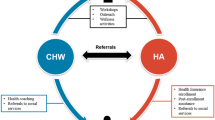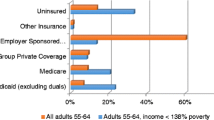Abstract
Most proposals to improve access for uninsured adults focus on removing financial barriers to health care. Health services researchers have long recognized, however, that access to care is a multidimensional concept consisting of both financial and nonfinancial dimensions. While financial barriers faced by those without health insurance have been well-documented, it is not known to what degree nonfinancial barriers limit access for those without coverage. In this study we sought to identify the types and frequencies of nonfinancial access barriers faced by low-income uninsured adults, as well as determine how frequently nonfinancial barriers coexist with financial access barriers in this population. We conducted a telephone survey of 1,118 low-income uninsured adults in Alameda, California, Austin, Texas, and Southern Maine who had enrolled in local access programs funded through the Robert Wood Johnson Foundation’s Communities in Charge initiative. Financial barriers were the most often cited barrier to access in each of the three groups, though nonfinancial barriers were often cited as well. Across all three populations, one-third to one-half of respondents with financial access barriers also cited one or more nonfinancial barriers as contributing to their problems accessing health care. Our results suggest that many uninsured adults face nonfinancial health care barriers in addition to their well-documented financial challenges. Health reform efforts must address both types of barriers in order to maximally improve access for the uninsured population.
Similar content being viewed by others
References
McDonough, J. E., Miller, M., & Barber, C. (2008). A progress report on state health access reform. Health Affairs, 27(2), w105–w115.
Kaiser Commission on Medicaid and the Uninsured. (2009, May 19). States moving toward comprehensive health reform. Retrieved from http://www.kff.org/uninsured/upload/State-Health-Reform1.pdf.
Connolly, C. (2008, November 12). Senators hurry to keep health care in forefront. Washington Post, pp. A8.
Hook, J., Levey, N. N., & Nicholas, P. (2008, November 13). Congress is itching to get started; on healthcare and the economy, leaders are not waiting for Obama. Los Angeles Times, pp. A1.
Levey, N. N. (2008, December 1). Health reform goals sharpen; medical political and business interests seem to agree now that bold federal action is necessary. Los Angeles Times, pp. A1.
Barack Obama and Joe Biden’s plan to lower health care costs and ensure affordable, accessible health coverage for all. (n.d.). Retrieved from http://www.barackobama.com/pdf/issues/HealthCareFullPlan.pdf.
Aday, L. A. (1975). Economic and non-economic barriers to the use of needed medical services. Medical Care, 13(6), 447–456.
Aday, L. A., & Andersen, R. (1974). A framework for the study of access to medical care. Health Services Research, 9(3), 203–220.
Andersen, R., & Newman, J. F. (1973). Societal and individual determinants of medical care utilization in the U.S. Milbank Memorial Fund Quarterly, 51(1), 95–124.
Donabedian, A. (1972). Models for organizing the delivery of personal health services and criteria for evaluating them. Milbank Memorial Fund Quarterly, 50(4), 103–154.
Penchansky, R., & Thomas, J. W. (1981). The concept of access: Definition and relationship to consumer satisfaction. Medical Care, 19(2), 127–140.
Thomas, J. W., & Penchansky, R. (1984). Relating satisfaction with access to utilization of services. Medical Care, 22(6), 553–568.
Andersen, R. M. (1995). Revisiting the behavioral model and access to medical care: Does it matter? Journal of Health and Social Behavior, 36(1), 1–10.
Gold, M. (1998). Beyond coverage and supply: Measuring access to healthcare in today’s market. Health Services Research, 33(3 Pt 2), 625–652.
McLaughlin, C. G., & Wyszewianski, L. (2002). Access to care: Remembering old lessons. Health Services Research, 37(6), 1441–1443.
Millman, M. (Ed.). (1993). Access to health care in America. Washington, DC: National Academy Press.
Roby, D. H., Kominski, G. F., & Cameron, M. E. (2007). Improving access through health insurance coverage and safety net expansion: review of the literature. Retrieved from http://www.healthpolicy.ucla.edu/pubs/files/Safety_Net_Expansion_PB_091407.pdf.
Hall, A. G., Lemak, C. H., Steingraber, H., & Schaffer, S. (2008). Expanding the definition of access: It isn’t just about health insurance. Journal of Health Care for the Poor and Underserved, 19(2), 625–638.
Cunningham, P. J., & Hadley, J. (2007). Differences between symptom-specific and general survey questions of unmet need in measuring insurance and racial/ethnic disparities in access to care. Medical Care, 45(9), 842–850.
Kalsbeek, W. D. (2003). Sampling minority groups in health surveys. Statistics in Medicine, 22(9), 1527–1549.
Ortega, A. N., Fang, H., Perez, V. H., Rizzo, J. A., Carter-Pokras, O., Wallace, S. P., et al. (2007). Health care access, use of services, and experiences among undocumented Mexicans and other Latinos. Archives of Internal Medicine, 167(21), 2354–2360.
Sack, K. (2008, April 5). In Massachusetts, universal coverage strains care. New York Times, pp. A1.
Hill, I., Palmer, L., & Courtot, B. (2008, June). Coverage is not enough: Lessons from the Covering Kids and Families Access Initiative. Paper presented at the Academy Health Annual Research Meeting, Washington, DC, USA.
Hoffman, C., & Paradise, J. (2008). Health insurance and access to health care in the United States. Annals of the New York Academy of Sciences, 1136, 149–160.
Varney, S. (2009). New California rules cut wait times for medical care. Retrieved from http://www.npr.org/templates/story/story.php?storyId=112416514.
Brown, E. R., Wyn, R., & Teleki, S. (2000). Disparities in health insurance and access to care for residents across U.S. cities. Retrieved from http://www.healthpolicy.ucla.edu/pubs/files/DisparitiesInHealthInsuranceReport(MSA).pdf.
Hadley, J. (2003). Sicker and poorer: The consequences of being uninsured. Medical Care Research and Review, 60(2 Suppl), 3S–75S.
Hadley, J., & Cunningham, P. J. (2005). Perception, reality and health insurance: uninsured as likely as insured to perceive need for care but half as likely to get care, 100. Retrieved from http://www.rwjf.org/files/research/Issue%20Brief%20No%20%20100%20FINAL.pdf.
Institute of Medicine Committee on the Consequences of Uninsurance. (2002). Care without coverage: Too little, too late. Washington, DC: National Academies Press.
Institute of Medicine Committee on the Consequences of Uninsurance. (2001). Coverage matters: Insurance and health care. Washington, DC: National Academies Press.
Acknowledgments
This work was supported by a grant from the Robert Wood Johnson Foundation. We thank Leon Wyszewianski for comments on the study framework and John Ayanian for comments on an earlier draft of this manuscript.
Author information
Authors and Affiliations
Corresponding author
Rights and permissions
About this article
Cite this article
Kullgren, J.T., McLaughlin, C.G. Beyond Affordability: The Impact of Nonfinancial Barriers on Access for Uninsured Adults in Three Diverse Communities. J Community Health 35, 240–248 (2010). https://doi.org/10.1007/s10900-010-9230-0
Published:
Issue Date:
DOI: https://doi.org/10.1007/s10900-010-9230-0




